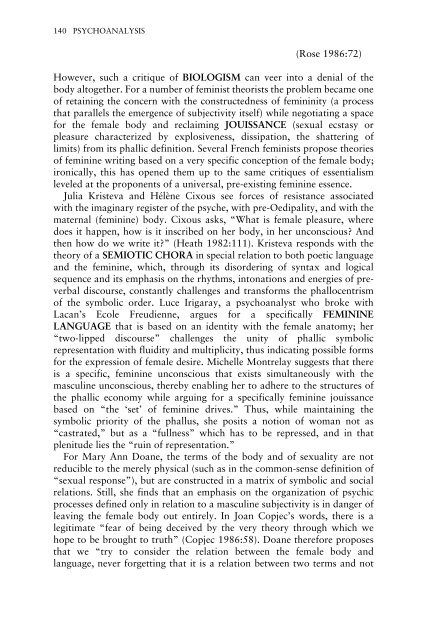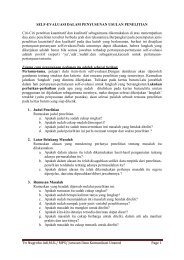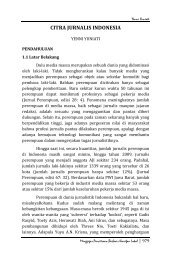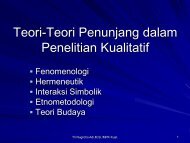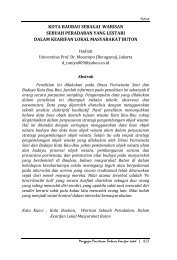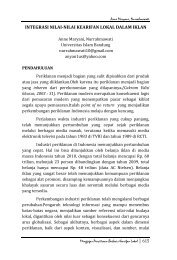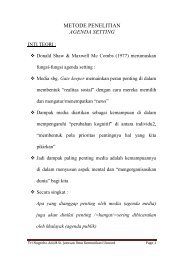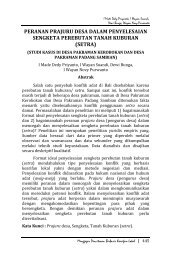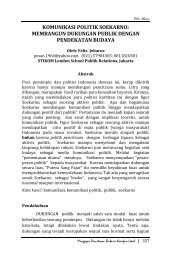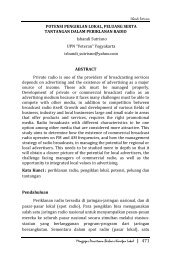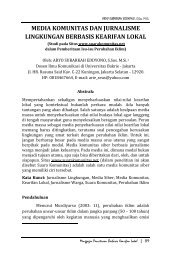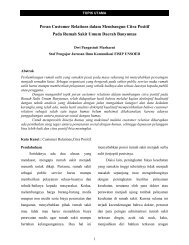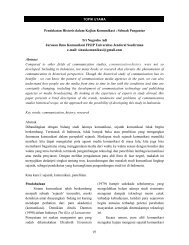New Vocabularies in Film Semiotics
New Vocabularies in Film Semiotics
New Vocabularies in Film Semiotics
Create successful ePaper yourself
Turn your PDF publications into a flip-book with our unique Google optimized e-Paper software.
140 PSYCHOANALYSIS<br />
(Rose 1986:72)<br />
However, such a critique of BIOLOGISM can veer <strong>in</strong>to a denial of the<br />
body altogether. For a number of fem<strong>in</strong>ist theorists the problem became one<br />
of reta<strong>in</strong><strong>in</strong>g the concern with the constructedness of fem<strong>in</strong><strong>in</strong>ity (a process<br />
that parallels the emergence of subjectivity itself) while negotiat<strong>in</strong>g a space<br />
for the female body and reclaim<strong>in</strong>g JOUISSANCE (sexual ecstasy or<br />
pleasure characterized by explosiveness, dissipation, the shatter<strong>in</strong>g of<br />
limits) from its phallic def<strong>in</strong>ition. Several French fem<strong>in</strong>ists propose theories<br />
of fem<strong>in</strong><strong>in</strong>e writ<strong>in</strong>g based on a very specific conception of the female body;<br />
ironically, this has opened them up to the same critiques of essentialism<br />
leveled at the proponents of a universal, pre-exist<strong>in</strong>g fem<strong>in</strong><strong>in</strong>e essence.<br />
Julia Kristeva and Hélène Cixous see forces of resistance associated<br />
with the imag<strong>in</strong>ary register of the psyche, with pre-Oedipality, and with the<br />
maternal (fem<strong>in</strong><strong>in</strong>e) body. Cixous asks, “What is female pleasure, where<br />
does it happen, how is it <strong>in</strong>scribed on her body, <strong>in</strong> her unconscious? And<br />
then how do we write it?” (Heath 1982:111). Kristeva responds with the<br />
theory of a SEMIOTIC CHORA <strong>in</strong> special relation to both poetic language<br />
and the fem<strong>in</strong><strong>in</strong>e, which, through its disorder<strong>in</strong>g of syntax and logical<br />
sequence and its emphasis on the rhythms, <strong>in</strong>tonations and energies of preverbal<br />
discourse, constantly challenges and transforms the phallocentrism<br />
of the symbolic order. Luce Irigaray, a psychoanalyst who broke with<br />
Lacan’s Ecole Freudienne, argues for a specifically FEMININE<br />
LANGUAGE that is based on an identity with the female anatomy; her<br />
“two-lipped discourse” challenges the unity of phallic symbolic<br />
representation with fluidity and multiplicity, thus <strong>in</strong>dicat<strong>in</strong>g possible forms<br />
for the expression of female desire. Michelle Montrelay suggests that there<br />
is a specific, fem<strong>in</strong><strong>in</strong>e unconscious that exists simultaneously with the<br />
mascul<strong>in</strong>e unconscious, thereby enabl<strong>in</strong>g her to adhere to the structures of<br />
the phallic economy while argu<strong>in</strong>g for a specifically fem<strong>in</strong><strong>in</strong>e jouissance<br />
based on “the ‘set’ of fem<strong>in</strong><strong>in</strong>e drives.” Thus, while ma<strong>in</strong>ta<strong>in</strong><strong>in</strong>g the<br />
symbolic priority of the phallus, she posits a notion of woman not as<br />
“castrated,” but as a “fullness” which has to be repressed, and <strong>in</strong> that<br />
plenitude lies the “ru<strong>in</strong> of representation.”<br />
For Mary Ann Doane, the terms of the body and of sexuality are not<br />
reducible to the merely physical (such as <strong>in</strong> the common-sense def<strong>in</strong>ition of<br />
“sexual response”), but are constructed <strong>in</strong> a matrix of symbolic and social<br />
relations. Still, she f<strong>in</strong>ds that an emphasis on the organization of psychic<br />
processes def<strong>in</strong>ed only <strong>in</strong> relation to a mascul<strong>in</strong>e subjectivity is <strong>in</strong> danger of<br />
leav<strong>in</strong>g the female body out entirely. In Joan Copjec’s words, there is a<br />
legitimate “fear of be<strong>in</strong>g deceived by the very theory through which we<br />
hope to be brought to truth” (Copjec 1986:58). Doane therefore proposes<br />
that we “try to consider the relation between the female body and<br />
language, never forgett<strong>in</strong>g that it is a relation between two terms and not


